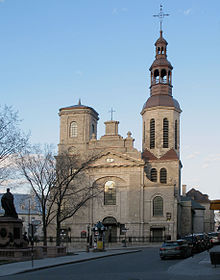Notre-Dame de Québec Cathedral
| Notre-Dame de Québec | |
|---|---|

Cathedral-Basilica of Notre-Dame de Québec
|
|
| 46°48′49.61″N 71°12′21.97″W / 46.8137806°N 71.2061028°WCoordinates: 46°48′49.61″N 71°12′21.97″W / 46.8137806°N 71.2061028°W | |
| Location | 16, rue de Buade Quebec City, Quebec G1R 4A1 |
| Country | Canada |
| Denomination | Roman Catholic |
| History | |
| Founded | 1647 |
| Dedication | Virgin Mary |
| Past bishop(s) | François de Laval |
| Architecture | |
| Status | Basilica cathedral |
| Functional status | Functional |
| Designated | 1989 |
| Architect(s) | Jean Baillairgé |
| Architectural type | Neoclassical |
| Completed | 1843 |
| Administration | |
| Archdiocese | Quebec |
| Official name | Notre-Dame Roman Catholic Cathedral National Historic Site of Canada |
| Designated | 1989 |
The Cathedral-Basilica of Notre-Dame de Québec ("Our Lady of Quebec City"), located at 16, rue de Buade, Quebec City, Quebec, is the primatial church of Canada and the seat of the Roman Catholic Archdiocese of Quebec, the oldest in the Americas north of the Spanish colonies in Florida and New Mexico. It is also the parish church of the oldest North American parish north of Mexico and was the first north of Mexico to be elevated to the rank of minor basilica, by Pope Pius IX in 1874. It is a National Historic Site of Canada, and located within the UNESCO World Heritage Site of Historic District of Old Québec.
Located on this site since 1647, the cathedral has twice been destroyed by fire throughout the centuries.
A previous iteration of the church was destroyed during the Siege of Quebec in 1759. It was rebuilt from plans by Gaspard-Joseph Chaussegros de Léry draughted in 1743. The belltower, however, was designed by Jean Baillairgé, who also oversaw construction. The interior was designed by Jean Baillairgé and his son François from 1786–1822. In 1843, François' son, Thomas, suggested a reconstruction of the façade to resemble the church of Sainte-Geneviève in Paris, resulting in the finest Neo-classic façade in Québec. The cathedral was richly decorated with impressive works of art: baldaquin, canopy, episcopal throne dais, stained glass windows, paintings, and chancel lamp (a gift of Louis XIV).
...
Wikipedia

